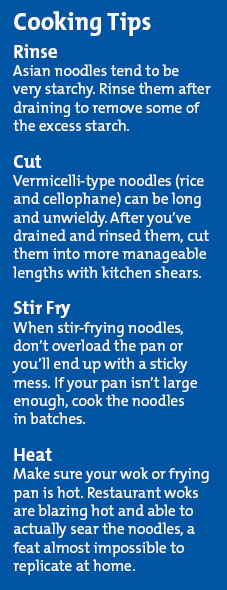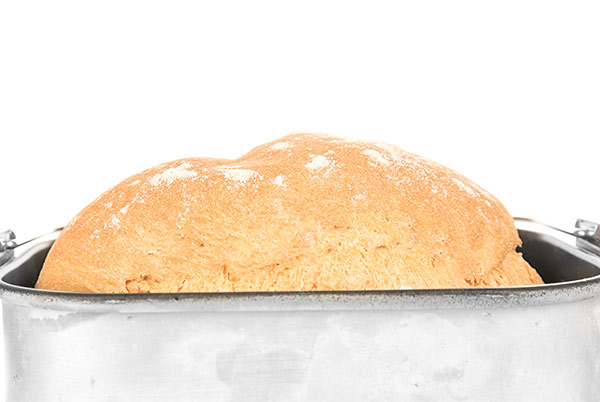Get to Know Your Gluten-Free Asian Noodles
Updated Feb 16, 2021, Published Dec 28, 2011
This post contains affiliate links. Please see our disclosure policy.
Asian-style dishes with an allergy-friendly twist!
The first time I stood in the noodle aisle of an Asian market, my head was spinning. The sheer quantity of noodles was overwhelming and the task of sorting through the different varieties in search of gluten-free choices seemed completely insurmountable.
If you’ve avoided Asian noodles, daunted by the task of finding safe options, here’s help. We’ve untangled the basics and made it simple: Noodle types are separated into categories based on their main ingredient. All you have to do is choose the noodle variety best suited for your palate and your special dietary needs. Then select a recipe—and start cooking!
Rice Noodles
Dried noodles made from a combination of rice flour and water, rice noodles range in thickness from super-thin, brittle rice vermicelli to long, flat noodles, such as those used in pad Thai. Names on packaging vary considerably. Depending on the width of the noodles, they may be called mai fun, bun, sen mee, jantaboon, rice sticks or vermicelli. Take a look at the noodles themselves (flat or round, wide or thin) when determining what you need. Generally, the recipe will guide you in choosing the correct type.
Rice noodles cook quickly. The thinnest rice vermicelli needs only a soak in just-boiled water before it’s used as a stuffing for salad rolls. Larger, wider rice noodles are often soaked in warm water as a first step and then boiled or stir-fried to finish the cooking. Always rinse cooked noodles in cold water to remove excess starch before proceeding with a recipe.
Fresh rice noodles, often found refrigerated in Asian markets, can be gluten free—but not always. Buy only well-labeled packages and read the ingredient list carefully, as fresh rice noodles can sometimes contain wheat starch or wheat flour.
Cellophane Noodles
Dried noodles made from the starch of mung beans and water, cellophane noodles appear very white in their dried form but become transparent once they’re cooked. They go by many names, including mung-bean noodles, glass noodles, bean threads, sai fun and harasume. Their neutral flavor makes them a versatile ingredient in many dishes.
Cellophane noodles come in two sizes, one whisper-thin for stuffing spring rolls and a slightly thicker spaghetti-like noodle for stir-fries. Soak the noodles for about 15 minutes in warm water, drain them and then cut them into smaller pieces (I use kitchen shears) before finishing them off in a stir-fry or simmered dish.
Korean tangmyon is a type of cellophane noodle made from sweet potato starch. These noodles are slightly thicker than mung-bean noodles but generally prepared in a similar way; just add a few extra minutes to the cooking time. Finding tangmyon usually requires a trip to the Asian market (maybe even a Korean market), while mung-bean noodles are becoming more available in grocery stores and natural food markets.
Soba Noodles
Dried noodles made from buckwheat flour (gluten free despite the “wheat” in its name), water and usually some percentage of wheat flour. The only soba noodles safe to eat in a gluten-free diet are those labeled 100 percent buckwheat soba.
Buckwheat noodles feel substantial, with a hearty chew and a hint of nuttiness. They can be simply boiled and served (rinse off the extra starch first) or subsequently stir-fried. They don’t need any pre-soaking.
You can find 100 percent buckwheat soba noodles (Eden or Mitoku are great brands) in natural food stores and upscale groceries. Avoid buying soba in Asian markets—unless you see one of the brands just mentioned—because the label translation tends to be confusing.
A type of Korean buckwheat noodle called naengmyon supposedly combines buckwheat and sweet potato starch. I’ve never seen an entirely gluten-free version but check around in your area.
Japanese and Korean restaurants often serve soba noodles. Before you order, always inquire whether they’re completely gluten free; chances are slim.
Other Noodles
Rice noodles, cellophane noodles and even buckwheat soba can be reasonably easy to find in grocery stores and natural food markets. If you have time to poke around an Asian market, you may unearth additional treasures.
I’ve come across gluten-free noodles made from acorn starch, potato starch, tapioca and even kuzu root. Read the packages for cooking directions. Once you get to know them, you may find them interesting substitutes for rice or cellophane noodles.
In the refrigerated section, you might find water-packed shirataki “noodles” or kelp “noodles.” While these products are noodle shaped, texturally they don’t always make suitable substitutes for more standard types of noodles.
Welcome to the big, beautiful world of gluten-free, dairy-free cooking with delicious Far Eastern flair. These allergy-friendly recipes are easy and certain to please the most discriminating palates.

Vietnamese-Style Rice Vermicelli Salad with Grilled Pork
Ingredients
- 2 tablespoons vegetable oil
- 3 cloves garlic, , minced, divided
- ¼ cup + 3 tablespoons gluten-free Asian fish sauce, , divided
- 4 tablespoons sugar, , divided
- Grated zest of 1 lime
- ¼ teaspoon crushed red pepper flakes
- 1 pound thin (¾-inch thick or less) boneless pork chops
- 6 tablespoons fresh lime juice
- 1 tablespoon sliced jalapeño chile, , more to taste
- 1 (6.75-ounce) package dried rice vermicelli
- 1 cup thinly sliced seeded cucumbers
- 3 cups shredded or thinly sliced mixed vegetables, , such as carrots, lettuce, daikon radish, green onions, bean sprouts
- 1 cup lightly packed fresh cilantro and/or mint leaves
- ⅓ cup sunflower seeds or chopped peanuts, , optional
Instructions
- In a bowl large enough to hold the pork chops, combine oil, half the garlic, ¼ cup fish sauce, 2 tablespoons sugar, lime zest and red pepper flakes. Mix well to incorporate the sugar. Add pork chops and marinate at room temperature for up to an hour or refrigerate for several hours or overnight.
- Combine remaining garlic, 3 tablespoons fish sauce, 2 tablespoons sugar, lime juice and jalapeño in a small bowl. Cover until ready to use. (Sauce can be made a day ahead and stored, covered tightly, in the refrigerator.)
- Bring a medium pot of water to a boil. Add rice vermicelli and turn off the heat. Let noodles stand until cooked (taste one to check for doneness), about 3 minutes or according to package directions. Drain noodles in a colander and rinse with cold water. Let noodles drain well (and even give them a little squeeze) to remove excess water. If you want, snip the noodles into smaller lengths with kitchen shears.
- Heat the grill to moderate heat. Remove the pork from marinade and wipe away any excess. Grill the pork, turning once, until done, 3 to 4 minutes per side for ¾-inch thick chops. Remove meat from the grill and set it on a cutting board.
- Toss noodles, vegetables and herbs with the sauce and place salad on a large platter. Cut the pork into thin slices and place them over the salad. Top with sunflower seeds or chopped peanuts, if desired.
Nutrition
Nutrition information is automatically calculated, so should only be used as an approximation.

Red Curry Soup with Chicken and Rice Noodles
Ingredients
- 8 ounces flat rice noodles
- 1 pound boneless, skinless chicken breasts,, cut crosswise into thin slices and then into strips
- 2 tablespoons gluten-free Asian fish sauce
- 2 tablespoons vegetable oil
- 1 small onion, , thinly sliced
- 2 cloves garlic, , minced
- 3 tablespoons gluten-free red curry paste
- ½ teaspoon turmeric
- ½ teaspoon ground coriander
- ¾ teaspoon salt
- 2 (14-ounce) cans unsweetened coconut milk
- 2 cups gluten-free chicken broth
- Cilantro leaves, , for serving
- Shredded cabbage, , for serving
- Lime wedges, , for serving
- Gluten-free sriracha or other chili- garlic sauce, , for serving
Instructions
- Cook noodles in a large pot of boiling water until just done, about 5 minutes, or according to package directions. (Remove a noodle with tongs and taste it for doneness.) Drain noodles in a colander and rinse with cold water to stop the cooking. Set aside.
- In a small bowl, toss chicken with fish sauce. Let stand while you prepare the soup.
- In a pot, heat oil over medium heat. Add onions and cook, stirring occasionally, until starting to brown, about 10 minutes. Stir in garlic, curry paste, turmeric and coriander and cook, stirring, for about 1 minute. Add salt, coconut milk, and chicken broth and bring to a boil. Lower heat and simmer, partially covered, to infuse the flavors, 10 to 15 minutes.
- Add chicken and fish sauce to the simmering broth. Continue cooking until chicken is cooked through, about 5 minutes.
- To serve, divide noodles among 4 bowls and ladle the soup over the noodles. Top with cilantro, cabbage, a squeeze of lime juice and hot sauce, to taste.
Notes
Nutrition
Nutrition information is automatically calculated, so should only be used as an approximation.

Gluten-Free Stir-Fried Cellophane Noodles with Spinach and Beef
Ingredients
- 6 ounces cellophane noodles
- 12 ounces ground beef
- 2 tablespoons sake
- 4 tablespoons gluten-free tamari, , divided
- ¾ cup gluten-free chicken broth
- 1 teaspoon sugar
- 2 teaspoons gluten-free chili garlic sauce or sriracha, , more for serving
- ¼ teaspoon freshly ground black pepper
- 2 tablespoons vegetable oil, , divided
- 1 tablespoon grated fresh ginger
- 3 carrots, , peeled and thinly sliced diagonally
- 1 (5-ounce) package baby spinach
Instructions
- Soak noodles in a bowl of hot water until softened, about 15 minutes. (If a noodle bounces back after it’s stretched, they’re done.) Drain noodles in a colander and cut them into smaller lengths with scissors. Put noodles in a large bowl.
- In a small bowl, stir together uncooked beef, sake and 1 tablespoon tamari.
- In a measuring cup, stir together remaining 3 tablespoons tamari, chicken broth, sugar, chili garlic sauce and black pepper. Set sauce aside.
- Heat 1 tablespoon oil in a large (14-inch) frying pan or wok over moderately high heat. Add ginger and cook until fragrant, about 20 seconds. Add meat and cook, stirring frequently until browned, 4 to 5 minutes. Drain meat in a colander and add to noodles.
- Heat remaining tablespoon of oil in the same pan over moderately high heat. Add carrots and cook, stirring frequently, until they start to soften, about 2 minutes. Stir in spinach and cook until wilted.
- Add noodles, meat and sauce to the pan. Toss with tongs to combine and then simmer until noodles are just tender and absorb most of the sauce, 3 to 5 minutes longer.
Nutrition
Nutrition information is automatically calculated, so should only be used as an approximation.

Gluten-Free Soba Noodles with Stir-Fried Shiitake Mushrooms
Ingredients
- 1 (7 to 8-ounce) package 100 percent buckwheat soba noodles
- 2 tablespoons vegetable oil
- 1 small onion, , thinly sliced
- 8 ounces shiitake mushrooms, , stems removed, caps thinly sliced
- 6 ounces asparagus, , cut diagonally into ½-inch slices (about 1 cup)
- ¼ cup gluten-free tamari
- 2 tablespoons sake
- ⅛ teaspoon red pepper flakes
- 1 teaspoon toasted sesame oil
- ¼ cup chopped fresh cilantro
- ½ teaspoon freshly ground black pepper
Instructions
- Cook noodles in a large pot of boiling water until just done, about 8 minutes, or according to package directions. (Remove a noodle with tongs and taste it for doneness.) Drain noodles in a colander and rinse with cold water to stop the cooking. Set aside.
- Heat oil over medium-high heat in a large frying pan or a wok. Add onions and mushrooms and cook, stirring occasionally, until onions are well browned, about 10 minutes. Add asparagus and cook, stirring, about 2 minutes longer.
- Stir in cooked noodles, tamari, sake and red pepper flakes. Toss with tongs until heated through, 2 to 3 minutes.
- Top noodles with sesame oil, cilantro and black pepper. Serve hot.
Nutrition
Nutrition information is automatically calculated, so should only be used as an approximation.
Check out more Asian-inspired gluten-free recipes!
Recipes reprinted with permission from The Gluten-Free Asian Kitchen (Ten Speed Press Celestial Arts), by Laura B. Russell.
Cookbook author Laura B. Russell writes the Gluten Freedom column for the Oregonian and Notes from a Gluten-Free Kitchen. She is former associate editor of Food & Wine cookbooks and a contributor to Prevention, Easy Eats, and Portland’s Mix magazines. She has followed a gluten-free diet since 2007.
Originally published in Gluten-Free & More.















That looks delicious! I need some of that in my life, I am definetly trying this recipe!
I’m so very excited! I love ramen noodles….. Going to prep these this weekend for lunch next week.
OHHH this looks SO GOOD! I am totally going to make this.
Made it last night using chicken. Loved it. Even picky son loved it. Also I added a bit more of soy sauce and about a cup of chicken broth for more sauce just cause our family really likes a lot of sauce with noodles. Turned out great. Thank you! Blessings!